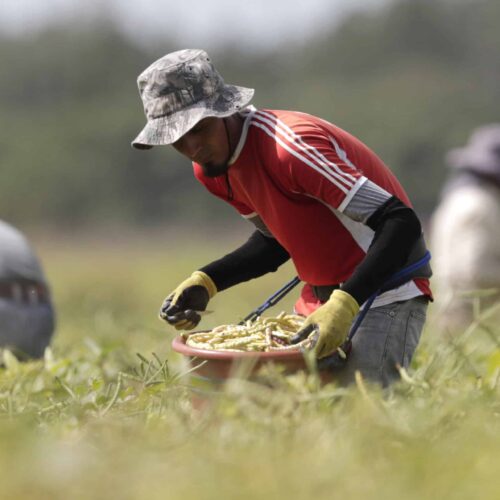This article was published in partnership with Mother Jones.
Introduction
Subscribe on Google | Apple Podcasts | Spotify | Amazon
He was a poultry worker and a Mexican immigrant. But those details weren’t documented when Rodolfo Tinoco became one of more than 204,000 who’ve died so far from COVID-19 in the United States.
Tinoco died May 12 at 63, after a month-long struggle in Gainesville, Georgia, a rural northeastern community in Hall County that calls itself the “Poultry Capital of the World.”
Georgia health officials argue it’s hard to know how Tinoco contracted the coronavirus. Tinoco’s family in Mexico says that the Hall County doctor who cared for Rodolfo said he probably was exposed at the Pilgrim’s Pride chicken-processing plant in Gainesville, where Tinoco worked for many years.
“The doctor said other workers had the virus, too,” said Rodolfo’s brother, Gerardo, reached in Zitácuaro, Mexico.
From public records, though, it’s hard to know that Rodolfo even worked in a poultry plant or that he died of COVID-19. His brief local obituary lists no job, place of birth or cause of death. Pilgrim’s Pride declined to confirm or deny he was an employee. And Georgia’s official COVID-19 website estimates only total cases and virus deaths suffered by Latinos statewide. The ethnicity of individuals who’ve died in each county isn’t disclosed — only victims’ ages, if they had a pre-existing condition and whether their race was white, African-American, Asian, unknown or other.
If a victim was Latino, as Tinoco was, it’s not noted. And that omission of ethnicity is significant.
Immigrants, especially Latinos, are risking their health in Hall County and across the country as essential workers who grow, harvest and process food for Americans — while many of their families are blocked from the most basic COVID-19 financial support, including federal stimulus checks, other taxpayers were eligible to receive. Nationwide, research shows Latinos are among the hardest hit by COVID-19.
A Center for Public Integrity county-by-county analysis drives home how crucial Latino immigrants are to U.S. farm and food-processing industries nationwide. The analysis was drawn from Census Bureau survey data collected by IPUMS USA at the University of Minnesota.
Focusing on 10 industries, Public Integrity found 1.87 million workers in front-line farm and food processing jobs, 790,000 of whom are immigrants. That’s about 43%, a share that’s two-and-a-half times the percent of immigrants in the total U.S. workforce. Nearly nine in 10 of the immigrant farm and food-processing workers are Latino. In some counties, the vast majority of thousands of workers are immigrants — 70%, 80%, even more than 90%. Nationwide, one-third of the 1.87 million are noncitizens.
Hire immigrants, vote Trump
In Georgia’s Hall County, the estimated share of immigrant noncitizens is even more pronounced. Public Integrity found that 78% of nearly 6,280 front-line food-production workers are immigrants. About 72% of these workers are Latino immigrants, and about 67% are Latino non-U.S. citizens. Some noncitizens could be undocumented. Some could have green cards, which gives them legal permanent resident status. Most are employees of poultry-processing factories that help make Georgia the number one state in the country for production of chicken.
The Pew Research Center estimates that 65% of the immigrant population in the Gainesville metropolitan area is undocumented. That’s the highest proportion in any metro area in the United States.
Gainesville and Hall County’s reliance on immigrant workers stands in contrast to its political preferences. The town has a population of 43,232 and is 42% Latino. Hall County’s population of 204,441 is 29% Latino. But 73% of Hall County voters in 2016 supported President Donald Trump, who has called for the mass deportation of undocumented immigrants and the curtailing of legal immigration that the U.S. food industry relies on.

Gainesville Mayor Danny Dunagan, who owns a dry cleaning business, is among those who supported Trump. “I’m not a socialist, and that’s what Democrats are going toward,” he said. He claimed that Trump’s not against immigrants: “He just wants them to come legally.”
Arturo Adame, a 29-year-old Latino, grew up in Hall County and many of his older family members were poultry workers.
He’s concerned about workers’ safety and has volunteered to pass out masks to employees as they come and go from plants that run round the clock. He’s disturbed at what he perceives is hypocritical support for Trump while the community profits from immigrant labor.
“We have chicken festivals, and chicken statues in town,” Adame said. “But when it comes to immigration, they just put their heads under the covers.”
Hall County resident Maria Del Rosario Palacios, 30, believes Trump played on racism — and Americans’ unfamiliarity with the immigration system — to win support in 2016, even in communities that depend heavily on immigrant labor.
Once undocumented herself, Palacios told Public Integrity about Tinoco’s death. She said she feels that he died in obscurity and unfairly, after laboring in an industry now operating under an executive order Trump issued April 29 that forced it to stay open to keep the meat supply coming.
Tinoco was her mother’s co-worker. For much of the summer, Palacios said, her mother has been sick with COVID-19. She’s been living on disability payments that are 60% of her salary.
A virus hotspot
Tinoco was also undocumented until he received amnesty through a law President Ronald Reagan signed in 1986, his brother Gerardo said. Unlike the majority of Hall County immigrants, Rodolfo died an American, he said, because the amnesty enabled him to apply for U.S. citizenship.
Although Pilgrim’s Pride declined to confirm or deny Tinoco’s employment, the company sent a statement: “While we cannot know for certain how, where or when a team member has been infected given the widespread nature of the virus, each case is heartbreaking. Our sympathies go out to everyone who has been impacted by this common enemy we all face.”
The Northeast Georgia Health System, in which Tinoco was treated, also sent a statement in response to what Gerardo Tinoco said about how his brother contracted the virus. “Unfortunately, our physicians cannot prove whether Mr. Tinoco was exposed to the virus during a trip to the grocery store, while pumping gas, when working or elsewhere,” wrote infections specialist Sandy Bozarth.
Since Tinoco’s death, Hall County has steadily remained a virus hot spot in Georgia, with Latinos disproportionately affected, according to local tracking the county submits to the state. Latinos who are mostly of Mexican origin represent 29% of county residents but have often accounted for half of COVID-19 cases. By Sept. 25, with cases still spiking, Latinos accounted for at least 34% of at least 9,147 virus cases. The ethnicity of 23% of the people known to have COVID-19 in the county is “unknown,” records at that time show.
Pressed for information on the ethnicity of Hall County residents who’ve died, county officials provided Public Integrity with internal lists of unnamed individuals. As of Sept. 25, at least 30 of 151 residents who’d died were Latino, according to the county. But the internal list omits individuals’ occupations and ages, making it impossible — just like state records — to track how many Latino victims were working-age people, and who possibly could have been workers in poultry plants.
On May 8, the Centers for Disease Control and Prevention (CDC) warned that workers at meatpacking plants had died and that plants are vectors for the coronavirus. The agency urged plants to take “prompt action” to reduce risk by requiring protective gear for workers and instituting distancing measures.

Mike Giles, president of the Gainesville-based Georgia Poultry Federation, an industry group, declined an interview. But in an email he said that poultry plants have instituted CDC-recommended safety measures, including taking workers’ temperatures, disinfecting work surfaces, requiring masks and face shields, installing partitions between workers and implementing stay-at-home policies for those who are sick. He provided a link to another industry group, the National Chicken Council, for details.
“I do not have access to each company’s policy,” Giles wrote, “but paid sick leave and relaxing of sick leave policies have been common practices in the industry during the response.”
The backbone of an industry
The essential workers identified in Public Integrity’s analysis of the food industry produce, process and transport crops and meat, dairy products and baked goods, and keep equipment working. Their work increases risk of virus exposure because they’re in close contact with one another at worksites and in transit. With some exceptions — such as farms that plowed under spring crops because restaurants shut down — many worksites remained open or reopened early in the pandemic while other businesses were shutting down to stop the spread of COVID-19.
About 37% of the 790,000 workers identified as immigrants nationwide are in California, the nation’s biggest supplier of fruits, vegetables and dairy products. Florida, Washington state and Arizona also have large shares. Latino immigrants are also the backbone of food-production businesses throughout the United States — including many counties that, like Hall County, voted heavily in 2016 for Trump.
In the chicken-processing center of Marshall County, Alabama, for example, out of an estimated 2,060 food-production workers, the biggest concentration in Alabama, 51% are immigrants — with 75% of 614 poultry butchers who are non-U.S. citizens mostly of Latino descent.
Trump vowed not only to deport undocumented Mexican workers during his campaign, he also vowed to slash legal immigration, attacking mostly Latino and Asian newcomers as “low-skilled” and a fiscal burden on Americans. Many legal immigrants eligible for sponsorship by relatives have historically been willing to go into these grueling farm and processing jobs or other lower-wage jobs as they begin a new life.
The U.S. Department of Agriculture estimates roughly half of farmworkers nationally are undocumented residents of U.S. communities.
“If you’re so against undocumented immigrants, then just stop eating 50% of what’s on your plate, right now,” said Erik Nicholson, who was a national vice president of the California-based United Farm Workers union (UFW) until he resigned last month to become a consultant.
Giles of the Georgia Poultry Federation said that in the past, the federation had supported immigration reform proposals that would have legalized longtime undocumented workers. Labor unions also support legalization.
But for 20 years, Congress failed to reform immigration laws, and employers continued to hire undocumented workers. During the Trump presidency, the poultry federation has gone largely silent on the topic, as Trump solidified a fervent “no amnesty” GOP position.
“We need them for the economy,” said Dunagan, Gainesville’s mayor.
But outside of a few temporary visas for seasonal specialty work only — to shell crabs, for example — the United States doesn’t grant visas to work in meatpacking, or to milk cows on dairies or perform year-round farm work, even if businesses prove domestic labor shortages.
There’s also no line for undocumented people in Hall County or anywhere else to legalize their status unless they have a family sponsor, who, in most cases, would have to be an American spouse or sibling. And even if they do have such a sponsor, if they dare come forward to try to petition to legalize, they’re at risk of mandatory exile from the United States for a minimum of 10 years as punishment for being undocumented.
Dunagan, like many Americans, said he was unaware of visa limits, or that Trump wants to slash family-sponsored immigration, eliminating that opportunity for parents and siblings of naturalized citizens. Dunagan said he’s not opposed to “idiots” in Washington figuring out how to legalize people whom industries need.
“But I don’t get into it that much, because there’s not much I can do about it,” he said.
Excluded from COVID-19 stimulus
Because of mostly Republican resistance in Congress, the Coronavirus Aid, Relief and Economic Security (CARES) Act passed in March excluded millions of undocumented workers in all industries, including food production, from COVID-19 stimulus checks. To cut out undocumented workers, the legislation excluded workers who file taxes using an Individual Taxpayer Identification Number (ITIN), as undocumented workers often do.
If an undocumented worker files taxes jointly with U.S. citizen or legal resident spouse, whole “mixed-status” families, including U.S. citizen children, are also excluded.
Local emergency cash programs to prevent evictions or utilities from being shut off — which have received COVID-19 federal relief money — are almost always off-limits to the undocumented, who don’t qualify for unemployment, either.
Advocates for immigrant workers urge extending COVID-19 cash relief to essential workers, regardless of immigration status and workers’ use of ITINs to file taxes.
In May, Democrats in the U.S. House of Representatives addressed this exclusion of undocumented workers and “mixed-status” families in the Health and Economic Recovery Omnibus Emergency Solutions (HEROES) Act. The proposal would widen eligibility to workers using ITINs to file taxes and would also shield essential workers from deportation during the pandemic. But the bill went nowhere in the Republican-controlled Senate.
Nicholson, who served 18 years with the UFW, pointed out that Congress and Trump gave specific bailouts for agribusiness employers who suffered virus-related crop losses, but didn’t obligate them to share funds with farmworkers. “Out of $9.5 billion in bailouts, to our dismay, not a single line item was there to protect farmworkers,” Nicholson said, referring to a provision to aid crop producers in the CARES Act.
Public Integrity spoke with two undocumented poultry workers in Hall County who both have spouses and children, and who were sick with COVID-19 for weeks in late spring. At times they were so ill they sought medical treatment, even though they don’t have health insurance. Once they recovered, neither were fully reimbursed for the workdays they lost.
Another undocumented poultry worker in Gainesville was sick in a local hospital while the worker’s spouse and children were left to rely on donations and support from others in the Latino community, the worker’s family told Public Integrity.
Latino-led civic groups in Hall County and other communities around the country are organizing food drives so immigrant families suffering income loss at least have food.
For Palacios, the virus has exposed systemic inequality in Hall County that predates the pandemic. She was a poultry worker as a younger woman and recalled a time when immigrant workers objected to conditions at a plant where she worked, only to be rebuffed by managers.
“Y’all got cousins out there who will take your jobs,” she said a manager told them.
A Georgia state law requires businesses with 10 or more workers to screen applicants with E-Verify, a computer system designed to flag fraudulent work authorization documents. But workers and businesses find ways around the system, immigrants say.
Farmworkers vulnerable, too
In April, when Trump ordered meat-packing companies to stay open, his executive order also authorized Secretary of Agriculture Sonny Perdue to require crop and food producers to continue operating should the administration decide it necessary.
Non-citizen immigrants dominate crop production even more than in meatpacking, Public Integrity’s data analysis shows.
Monterey County, California, known as the “Salad Bowl of the World,” produces more than $4 billion worth of crops a year, including 28% of the nation’s strawberries and more than half of U.S. lettuce. Public Integrity found that 88% of nearly 26,240 Monterey County crop and food-processing workers, including some who process seafood, are immigrants, 83% of them non-U.S. citizens.
A Monterey County immigrant farmworker — whose identity Public Integrity is not disclosing to protect her family — shares struggles similar to those of meatpackers in Hall County, Georgia. Originally from Mexico, the woman and her three children didn’t receive a stimulus check, even though she pays taxes and has been a farmworker here for 20 years.
“I’m in a mixed-status family, so I didn’t qualify, which is unjust,” she said.
Now 37, she obtained legal status through a visa program for crime victims who cooperate with law enforcement. But her tax-paying husband remains undocumented.
This summer, she’s harvesting strawberries from 6:30 a.m. to 2 p.m., five days a week. Her husband lost work for some weeks when the pandemic hit, enough to force the couple to have to borrow money to pay bills. “It’s all so much that I began to feel dizzy,” the farmworker said. “A doctor told me it’s vertigo from stress.”
Compared to other regions, Monterey’s local Latino-led health services are more supportive of workers, and the county stands out for its tracking of virus infections by occupation. At times, farmworkers have accounted for almost 40% of virus cases, although they’re 18% of the county’s labor force.
Since April, Monterey has promoted safety guidelines and limits on how many farmworkers can travel together on buses to reach work sites. It’s also set up shelters so infected workers can quarantine alone and avoid exposing families.
On June 11, the CDC and the U.S. Department of Labor published similar infection-control guidance for farm employers nationwide. Advocates warned of farmworkers’ vulnerability and appealed to administration officials to mandate safety measures. The Department of Labor rejected the appeals.
Since spring, virus outbreaks have erupted at farm worksites in New Jersey, North Carolina and California. Workers in Yakima County, Washington, went on strike in May to demand safer conditions in sheds where they pack the nation’s biggest supply of apples and sweet cherries. David Cruz, one of the workers striking, fell ill and was intubated for 18 days before he died. The virus is still affecting Latinos in Yakima at a far higher rate than white non-Latinos.
In New York state, an undocumented dairy worker became Cayuga County’s first virus-related fatality in April. Volunteers had to raise money to send his ashes home to Guatemala.
Nationwide, infections and deaths of farmworkers could be underreported because of language barriers and workers fear they’ll lose income if they have to quarantine, according to COVID-19 health researchers and the National Center for Farmworker Health.
In Santa Barbara County, California, health officials discovered in late July they’d been accidently undercounting COVID-19 deaths; out of 28 deaths that hadn’t been acknowledged, 10 victims were agricultural workers.
And in Michigan in August, employers sued to block an Aug. 3 state public health order requiring employers of 20 or more farmworkers to test them for the virus. Officials had already identified 21 outbreaks at worksites. Employers argued the order targeted Latino workers and thus violated their civil rights. A federal judge on Aug. 14 declined to block the order.
Public Integrity found that more than a quarter of front-line food-production workers in Michigan are immigrants. Among Florida’s much bigger population of food-production workers, 61% of about 67,830 workers are immigrants.
An undocumented farmworker from Mexico, who’s labored in Florida for 14 years and asked for anonymity, cares for orange groves in Highlands County for $10 an hour. Her husband’s hours in the field were slashed this spring when the pandemic shut down Florida tourism and demand for vegetables shrank. The family depends on donations that affluent Latinos have provided to increasingly destitute immigrant workers.
“This sickness is going to last,” the farmworker said.
Overlooking deaths?
Two days after Trump issued his executive order forcing food plants to re-open, the CDC issued its first report on COVID-19 among meat and poultry workers, with data submitted by fewer than half of the states. At least 20 workers had died by the end of April, and at least 4,913 had been infected in those states.
Four workers had perished in Delaware’s rural Sussex County, where Public Integrity found that immigrants comprise 88% of nearly 420 jobs as poultry butchers and 67% of 740 meat packagers. Delaware health officials declined to say if or how many of the dead were immigrants, arguing that disclosing that information could violate families’ privacy. The Washington Post reported on the death of one worker who was a Mexican immigrant.
A CDC update issued July 7 painted an ever darker picture. Data from 28 states indicated at least 16,233 processing workers had COVID-19 and 86 had died by May 31. According to the July CDC report, Georgia reported 509 poultry workers had been infected at 14 plants and one had died as of May 31.

In fact, by early April, four workers had succumbed to the virus at a Tyson’s Foods plant in Camilla, in southern Georgia. Three were Black women who were union workers. The Atlanta Journal-Constitution reported in May that two Latino men in their 60s had also died. The Latino men worked at a Fieldale Farms poultry plant in Habersham County, adjacent to Hall County.
Counting Rodolfo Tinoco’s unrecognized death in Hall County, at least seven poultry workers had died of the coronavirus in Georgia by the end of May.
Nancy Nydam, a Georgia Department of Health spokeswoman, said data reported to the CDC was accurate based on information the state had at the time. She also said Georgia health officials believe community spread — not workplace exposure — is the root of most virus cases.
“A death or infection in a poultry plant worker,” Nydam wrote, “is not likely attributed to an exposure in plant setting.”
A federal Occupational Health and Safety Administration spokesperson told Public Integrity that as of Sept. 2, only four Georgia poultry worker COVID-9 deaths had been reported to OSHA, none from Hall County.
Because government officials are failing to track cases systematically, the nonprofit Food & Environment Reporting Network is mapping accounts of COVID-19 infections and deaths of food-processing laborers and farmworkers. Based on news accounts and what data it can find, as of Sept. 15 the group has found at least 252 deaths and 59,079 virus cases nationwide.
In Mexico, Rodolfo Tinoco’s family is still mourning his passing. Rodolfo had remained close to family in Mexico, his brother Gerardo said. And as he lay weak in the hospital, Rodolfo would react when family would speak to him via Zoom. “Doctors said his heartbeat would change,” Gerardo said.
The family is now coping with more anguish. A cousin of the Tinocos — who is also a poultry worker — fell ill in Gainesville in August with COVID-19, Gerardo said. He died Sept. 10 in the same hospital where Rodolfo passed away in May.
Read more in Inequality, Opportunity and Poverty
Coronavirus and Inequality
White House coronavirus task force: ‘We are in a very dangerous place’
Post-Thanksgiving cases could put hospitals over the edge, task force warns.







Join the conversation
Show Comments